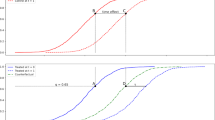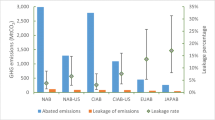Abstract
The Chicago Climate Exchange (CCX) and the Carbon Disclosure Project (CDP) are two private voluntary initiatives aimed at reducing carbon emissions and improving carbon management by firms. I sample power plants from firms participating in each of these programs, and match these to plants belonging to non-participating firms, to control for differences between participating and non-participating plants. Using a difference-in-differences model to control for unobservable differences between participants and non-participants, and to control for the trajectory of emissions prior to program participation, I find that the CCX is associated with a decrease in total carbon dioxide emissions for participating plants when non-publicly traded firms are included in the sample. Effects are produced largely by decreases in output. CCX participation is associated with increases in carbon dioxide intensity. The CDP is not associated with a decrease of carbon dioxide emissions or electricity generation, and program participation is associated with an increase in carbon dioxide intensity. I explore these results within the context of voluntary environmental programs to address carbon emissions.
Similar content being viewed by others
References
Allison PD (1990) Change scores as dependent variables in regression analysis. Sociol Methodol 20: 93–114
Ananathanarayanan A (1998) Is there a green link? A panel data value event study of the relationship between capital markets and toxic releases. Department of Economics Rutgers University, New Brunswick
Arimura TH, Hibiki A, Katayama H (2008) Is a voluntary approach an effective environmental policy instrument?: a case for environmental management systems. J Environ Econ Manag 55(3): 281–295
Berry W, Fording RC (1997) Measuring state tax capacity and effort. Soc Sci Q 78(1): 158–166
Boyd G, McClelland JD (1999) The impact of environmental constraints on productivity improvement in integrated paper plants. J Environ Econ Manag 38: 121–142
Caliendo M, Kopeinig S (2008) Some practical guidance for the implementation of propensity score matching. J Econ Surv 22(1): 31–72
Dasgupta S, Hettige H, Wheeler D (1997) What improves environmental performance: evidence from mexican industry. World Bank, Washington
Dehejia RH, Wahba S (2002) Propensity score-matching methods for nonexperimental causal studies. Rev Econ Stat 84(1): 151
DSIRE (2009) Rules, regulations, and policies for renewable energy. Retrieved 17 Sept 2009
Feldman SJ, Soyka P, Ameer P (1996) Does improving a firm’s environmental management system and environmental performance result in a higher stock price? ICF Kaiser International, Inc., Fairfax, VA
Gray W, Shadbegian R (2003) Environmental regulation, investment timing, and technology choice. J Ind Econ 46(2): 235–256
Hall B, Kerr ML (1991) Green index: a state-by-state guide to the nation’s environmental health. Island Press, Washington
Hamilton JT (1995) Pollution as news: media and stock market reactions to the toxic release inventory data. J Environ Econ Manag 28: 98–113
Heckman J, Robb R (1986) Alternative methods for solving the problem of selection bias in evaluating the impact of treatments on outcomes. In: Wainer H (ed) Drawing inferences from self-selected samples. Lawrence Erlbaum Associates, Inc., Mahwah, New Jersey, pp 63–107
Heckman J, Ichimura H, Smith J, Todd P (1996) Sources of selection bias in evaluating social programs: an interpretation of conventional measures and evidence on the effectiveness of matching as a program evaluation? method. Proc Natl Acad Sci 93(23): 13416–13420
Heckman J, Ichimura H, Todd P (1997) Matching as an econometric evaluation estimator: evidence from evaluating a job training programme. Rev Econ Stud 64: 605–654
Heckman J, LaLonde RJ, Smith JM (1999) The economics and econmetrics of active labor market policies. In: Ashenfelter O, Card D (eds) The handbook of labor economics, vol 3. Elsevier, Amsterdam, pp 1865–2097
Ho DE, Imai K, King G, Stuart E (2007) Matching as nonparametric preprocessing for reducing model dependence in parametric causal inference. Political Anal 15(3): 199–236
Ho DE, Kosuke I, King G, Stuart E (2007) Matching as nonparametric preprocessing for reducing model dependence in parametric causal inference. Political Anal 15(3): 199–236
Jung H, Pirog M (2011) Non-experimental impact evaluations. In: Besharov DJ, Cottingham PH (eds) The workforce investment act: Implenetation Experiences and evaluation findings. Upjohn Institute for Employment Research. Kalamazoo, Michigan, WE, pp 407–430
Khanna M (2001) Non-mandatory approaches to environmental protection. J Econ Surv 15(3): 291–325
Kim E-H, Lyon TP (2011a) Strategic environmental disclosure: evidence from the DOE’s voluntary greenhouse gas registry. J Environ Econ Manag 61(3): 311–326
Kim E-H, Lyon TP (2011b) When does institutional investor activism increase shareholder value?: the carbon disclosure project. BE J Econ Anal Policy 11(1)
King A, Lenox M (2000) Industry self-regulation without sanctions: the chemical industry’s repsonsible care program. Acad Manag J 43(4): 698–716
Kolk A, Levy D, Pinske J (2008) Corporate responses in an emerging climate regime: the institutionalization and commensuration of carbon disclosure. Eur Account Rev 17(4): 719–745
Kolk A, Pinske J (2005) Business responses to climate change: identifying emergent strategies. Calif Manag Rev 47(3): 6–20
LaLonde RJ (1986) Evaluating the econometric evaluations of training programs with experimental data. Am Econ Rev 76(4): 604
Leuven E, Sianesi B (2012) PSMATCH2: Stata module to perform full Mahalanobis and propensity score matching, common support graphing, and covariate imbalance testing. http://EConpapers.repec.org/RePEc:boc:bocode:s432001
Lyon TP, Maxwell JW (2004) Corporate environmentalism and public policy. Cambridge University Press, Cambridge
Lyon TP, Maxwell JW (2007) Environmental public voluntary programs reconsidered. Policy Stud J 35(4): 723–750
Matisoff DC (2008) The adoption of state climate change policies and renewable portfolio standards: regional diffusion or internal determinants?. Rev Policy Res 25(6): 527–546
Matisoff DC (2010) Making cap-and-trade work: lessons from the European Union Experience. Environ Sci Policy Sustain Dev 52(1): 10–19
Moffit R (1991) Program evaluation with nonexperimental data. Eval Rev 15(3): 291–314
Morgan S, Winship C (2007) Counterfactuals and causal inference: methods and principals for social research. Cambridge University Press, New York
Morgenstern R, Pizer W (eds) (2007) Reality check: the nature and performance of voluntary environmental programs in the United States, Europe, and Japan. Resources For the Future, Washington
Morgenstern R, Pizer W, Shih J-S (2007) Evaluating voluntary US climate programs: the case of climate wise. In: Pizer W, Morgenstern R (eds) Reality check: the nature and performance of voluntary environmental programs in the United States, Europe, and Japan. RFF, Washington
Pizer WA, Morgenstern R, Shih J-S (2011) The performance of industrial sector voluntary climate programs: climate Wise and 1605(b). Energy Policy 39(12): 7907–7916
Potoski M, Prakash A (2005) Covenants with weak swords: ISO 14001 and facilities’ environmental performance. J Policy Anal Manag 24(4): 745–769
Potoski M, Prakash A (2005) Green clubs and voluntary governance: ISO 14001 and firms’ regulatory compliance. Am J Political Sci 49(2): 235–248
Potoski M, Prakash A (2005) Green clubs and voluntary governance: ISO 14001 and firms’ regulatory compliance. Am J Political Sci 49(2): 235
Prakash A, Potoski M (2006) The voluntary environmentalists: green clubs, ISO 14001, and voluntary environmental regulations. Cambridge University Press, Cambridge
PricewaterhouseCoopers (2008) Carbon disclosure project report 2008: global 500. Carbon Disclosure Project, London
Reid EM, Toffel MW (2009) Responding to public and private politics: corporate disclosure of climate change strategies. Strateg Manag J 30(11): 1157–1178
Richards K (2000) Framing environmental policy instrument choice. Duke Environ Law Policy Forum 10: 221–231
Ringquist EJ (1993) Environmental protection at the state level. M.E. Sharpe, Armonk
Rivera J, De Leon P, Koerber C (2006) Is greener whiter yet? The sustainable slopes program after five years. Policy Stud J 34(2): 195–221
Shadbegian R, Gray W (2006) Assessing multi-dimensional performance: environmental and economic outcomes. J Prod Anal 26: 213–234
Smith J, Todd P (2005) Does matching overcome LaLonde’s critique of nonexperimental methods. J Econom 125: 305–353
Smith J, Todd P (2005) Rejoinder. J Econom 125: 365–375
Smith J, Zhang Y. (2009) The variety of balancing tests. Paper presented at the Association for Public Administration and Management, Washington
Victor D, House JC, Joy S (2005) A Madisonian approach to climate policy. Science 309(5742): 1820–1821
Vidovic M, Khanna N (2007) Can voluntary pollution prevention programs fulfill their promises? Further evidence from the EPA’s 33/50 program. J Environ Econ Manag 53: 180–195
Welch E, Barnum D (2009) Joint environmental and cost efficiency analysis of electricity generation. Ecol Econ 68(8-9): 2336–2343
Welch E, Mazur A, Bretschneider S (2000) Voluntary behavior by electric utilities: levels of adoption and contributions of the climate challenge program to the reductions of carbon dioxide. J Policy Anal Manag 19: 407–425
Author information
Authors and Affiliations
Corresponding author
Rights and permissions
About this article
Cite this article
Matisoff, D.C. Privatizing Climate Change Policy: Is there a Public Benefit?. Environ Resource Econ 53, 409–433 (2012). https://doi.org/10.1007/s10640-012-9568-0
Accepted:
Published:
Issue Date:
DOI: https://doi.org/10.1007/s10640-012-9568-0
Keywords
- Voluntary environmental programs
- Climate change policy
- Chicago climate exchange
- Carbon disclosure project
- Difference-in-differences model
- Propensity score matching
- Greenwash




